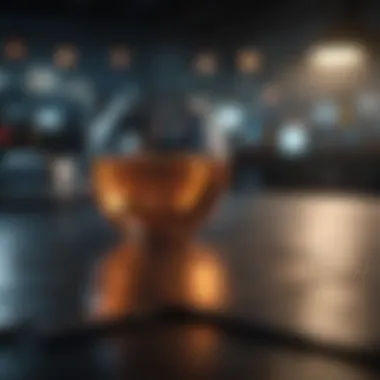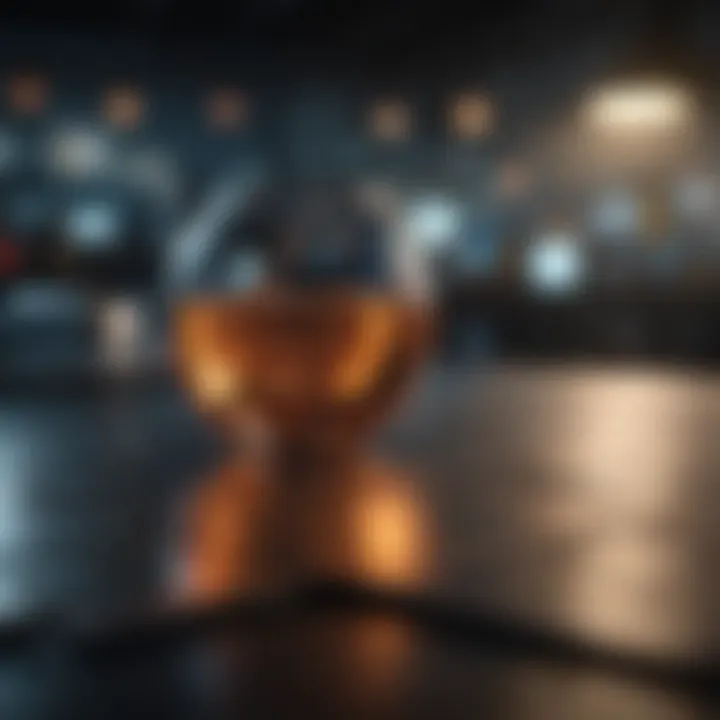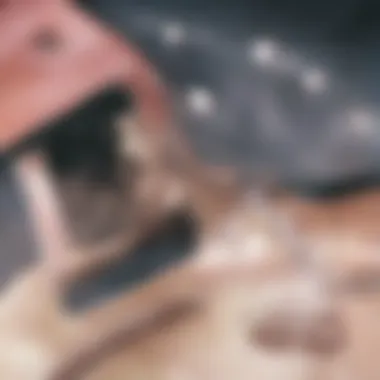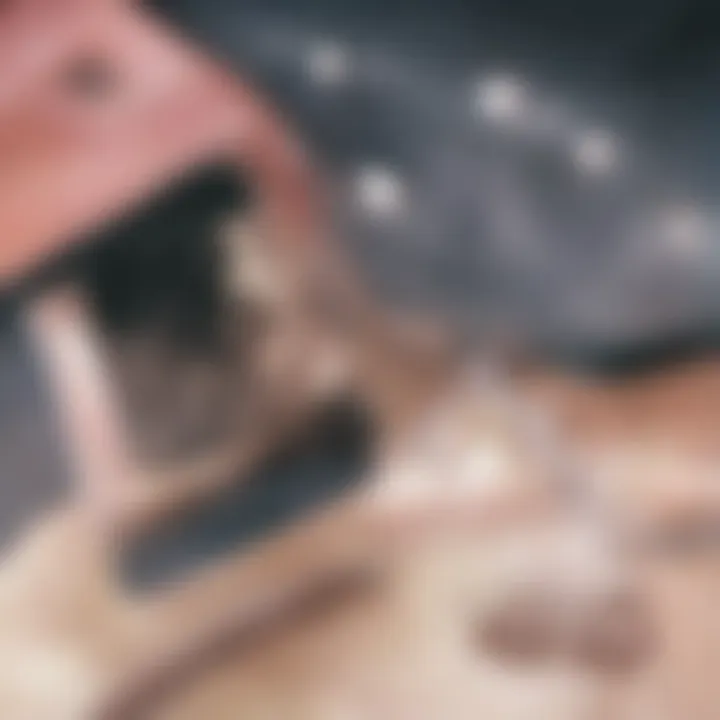The Impact of Layout on Scientific Communication


Intro
Layout is not just a matter of aesthetics in scientific communication; it is fundamental to how information is conveyed and understood. The way in which content is organized on a page or screen can influence the retention and engagement levels of the audience. This analysis aims to dissect the nuances of layout. By delving into visual hierarchy, readability, and cognitive load, we can uncover the layers that enhance or hinder communication.
Article Overview
Purpose of the Article
The main objective of this article is to illuminate the vital role that effective layout plays in scientific communication. It seeks to provide insight into how a carefully crafted layout can significantly improve comprehension and facilitate better engagement with scientific material. Through various analytical approaches, the article reveals how layout influences the audience's ability to grasp complex information, ultimately contributing to the dissemination of scientific knowledge.
Relevance to Multiple Disciplines
This discussion is pertinent not only to those in the scientific community but also to educators, students, and professionals across various fields. Effective layout can make a difference in how information is perceived in disciplines ranging from health sciences to engineering and social sciences. This makes the principles outlined here broadly applicable and essential for anyone dealing with the dissemination of information.
Research Background
Historical Context
The importance of layout in communication has been recognized since early publications. Historically, texts relied heavily on typographical conventions to guide readers. With the digital age, the challenge of layout has evolved. Researchers now face the need to present information in a manner that is not just visually appealing but also functionally effective. This evolution underscores the ongoing significance of research into layout strategies.
Key Concepts and Definitions
To frame this analysis, several key concepts must be acknowledged:
- Visual Hierarchy: Refers to the arrangement of elements in a way that suggests importance, guiding the reader's focus.
- Readability: Concerns the ease with which text can be read and understood, influenced by font choice, size, and spacing.
- Cognitive Load: Represents the mental effort required to process information. An ideal layout reduces cognitive load, allowing the audience to focus on understanding rather than struggling with how the information is presented.
"A well-designed layout can enhance understanding and retention of scientific material, making it accessible to a broader audience."
"A well-designed layout can enhance understanding and retention of scientific material, making it accessible to a broader audience."
Finale
The impact of layout on scientific communication is profound. As research continues to evolve, there is a strong need for consistent attention to these elements. By being mindful of layout, researchers not only enhance comprehension but also enrich the learning experience for their audience.
Prolusion
The significance of layout in scientific communication cannot be overstated. It serves as the framework that guides readers’ interactions with complex material. A well-considered layout not only enhances comprehension but also influences engagement. Researchers, educators, and students alike must recognize the profound effects that layout can have on the transmission of scientific data. When layout is done effectively, it can bridge the gap between intricate concepts and the audience. This article will dissect various elements involved in layout, emphasizing its importance in research dissemination.
Overview of Layout in Scientific Communication
Layout in scientific communication refers to the arrangement of text, visuals, and other elements that shape how information is presented. It is a critical consideration in articles, presentations, and posters. An organized layout can facilitate easier navigation through content while simultaneously highlighting essential information. Many times, layout decisions are influenced by established conventions within specific fields, which dictate what is considered effective. Developing a keen understanding of these conventions is necessary for optimizing scientific communication.
Importance of Layout in Research Dissemination
Layout plays an essential role in the dissemination of research. It determines how easily an audience can access, understand, and retain information. A person encountering a scientific article may quickly lose interest if the layout is cluttered or difficult to navigate. On the other hand, a clear layout can encourage thorough examination and critical engagement with the material.
The following points summarize the importance of layout in research dissemination:
- Clarity of Information: A logical flow to the content promotes better understanding and minimizes confusion.
- Audience Engagement: A visually appealing layout captures attention, fostering a connection with the material.
- Retention and Recall: Effective layouts aid memory by presenting information in a structured manner, making it easier for audiences to recall figures or concepts later.
"The impact of layout can resonate far beyond the page or screen; it shapes the very way knowledge is communicated."
"The impact of layout can resonate far beyond the page or screen; it shapes the very way knowledge is communicated."
For students and researchers, utilizing appropriate layout strategies is not merely an aesthetic choice; it is a responsibility to ensure that their findings are communicated effectively. This article will continue to unravel the many layers of layout’s impact on scientific communication, emphasizing its value across diverse disciplines.


Understanding Layout
Understanding layout is essential in the context of scientific communication. It encompasses how information is organized, structured, and presented. A thoughtful layout can significantly enhance the audience's ability to comprehend complex scientific concepts. This section elaborates on specific elements and considerations of layout that contribute to its effectiveness.
Definition and Components of Layout
Layout can be defined as the arrangement of visual elements on a page or screen. This includes text, images, graphs, and other multimedia components. Key components of layout are:
- Text arrangement: How body text, headings, and captions are displayed, which influences readability and engagement.
- Visual elements: The use of graphs, charts, and diagrams helps convey complex data succinctly.
- White space: This refers to empty spaces around elements, allowing readers to focus and reducing cognitive load.
- Consistent formatting: Adhering to uniform styles, fonts, and colors enhances cohesion and professionalism in presentation.
An effective layout does not overwhelm the reader. Instead, it leads their eye naturally from one element to another, emphasizing significant data and arguments.
The Science Behind Visual Presentation
Scientific research indicates that presentation layout impacts how information is processed. Studies show that people absorb information better when it is visually organized. Here are some scientific principles relevant to layout:
- Gestalt Principles: These psychological principles explain how humans perceive visual elements as a whole rather than parts. For instance, close proximity of related items promotes connection.
- Cognitive Load Theory: This principle suggests that the capacity of working memory is limited. A well-structured layout can aid memory retention by minimizing unnecessary cognitive load.
- Color Psychology: Different colors evoke varying emotions and responses. Applying appropriate color schemes can enhance communication by making content visually appealing and easier to navigate.
"Good layout is not just about aesthetics; it is about creating a bridge between complex data and reader understanding."
"Good layout is not just about aesthetics; it is about creating a bridge between complex data and reader understanding."
Elements of Effective Layout
The design of a scientific document or presentation significantly influences the way information is perceived. Elements of effective layout play a critical role in simplifying complex ideas, enhancing reader engagement, and improving overall understanding. When discussing layout in scientific communication, three primary factors stand out: visual hierarchy, readability, and cognitive load. These elements are essential in guiding readers through dense material and ensuring the key messages are communicated clearly.
Visual Hierarchy and its Implications
Visual hierarchy determines the organization and importance of information on a page. It employs size, color, spacing, and font style to lead readers' eyes to the most important elements first. This impacts how effectively readers can navigate through scientific content. For example, larger headings and bold text can highlight key sections, while bullet points can break down dense paragraphs into manageable pieces. This structured approach allows readers to quickly grasp the core ideas before delving deeper into the subtleties of the research.
Implementing visual hierarchy also avoids cognitive overload by managing the flow of information. When important details stand out, readers can focus on what matters most without getting lost in the details. Charts, graphics, and tables serve to support visual hierarchy, providing quick reference points for complex data.
Readability and Accessibility
Readability is another cornerstone of effective layout design. It refers not only to the ease with which text can be read but also to the accessibility of the content for diverse audiences. Scientific communication should be inclusive. Using plain language, clear formatting, and appropriate font sizes contributes to this goal. For example, using a sans-serif font can enhance readability on screens, making it easier for viewers to read long texts without strain.
Additionally, accessibility goes beyond mere readability. It should consider color blindness and the use of alt text in visual elements. When layout accommodates various abilities and backgrounds, it widens the reach of the information. As a result, scientific outreach becomes more effective, as more individuals can engage with and comprehend the material presented.
Cognitive Load and Information Processing
Cognitive load theory suggests that individuals have a limited capacity for processing information at any given time. Effective layout design minimizes unnecessary cognitive load, allowing readers to concentrate on understanding the content rather than struggling with its presentation. A well-structured layout helps manage the amount of information presented, breaking it down into smaller, digestible pieces.
Opting for short paragraphs, headlines, and subheadings is a practical method to reduce cognitive load. Graphs and visuals provide additional support, representing complex data in a straightforward manner. Thus, readers can process information more efficiently. Careful consideration of the layout design ensures that important insights are accessible without overwhelming the audience.
"An effective layout can serve as a bridge between complex information and reader understanding, making it easier to grasp intricate ideas."
"An effective layout can serve as a bridge between complex information and reader understanding, making it easier to grasp intricate ideas."
In summary, elements like visual hierarchy, readability, and cognitive load are intrinsic to creating an effective layout in scientific communication. By prioritizing these factors, researchers and communicators can significantly enhance the clarity and impact of their messages.
Analyzing Layout in Scientific Articles
The examination of layout in scientific articles is essential for various reasons. First, scientific articles serve as primary communication tools for researchers and educators. Effectively analyzing layout can enhance the understanding of complex ideas and results. This section breaks down both the advantages and considerations pertinent to layout, providing depth to the subject matter.
Good layout can lead to better comprehension. Studies show that well-structured articles allow readers to process information more effortlessly. Readers, whether they are students or seasoned researchers, benefit from a layout that guides them through the text. By focusing on clarity and organization, articles can significantly influence the retention of information.
Considerations when analyzing layout include visual consistency, component arrangement, and typography. Each of these elements plays a pivotal role in how information is perceived. Cohesive visual elements can create a more engaging reading experience.


Furthermore, a layout that balances text with visuals helps elucidate complex data. Research suggests that readers are more likely to absorb information that is presented clearly. This contributes to an overall increase in engagement, which is vital for fostering a rich academic environment.
"The success of a scientific article often hinges on its layout as much as its content."
"The success of a scientific article often hinges on its layout as much as its content."
Case Studies of Effective Layouts
Reviewing case studies of effective layouts highlights the best practices within scientific communication. Successful articles often prioritize layout that fosters clarity and navigation. For instance, articles published in Nature and Science implement consistent headings and subheadings, making the texts easier to skim.
- Article from Nature: Analyzed the structural elements in a study about climate change. The layout used bolded subheadings and bullet points that encapsulated key findings clearly, enhancing rapid comprehension.
- Article from PNAS: Focused on visual aids like graphs and tables that elucidated data trends. The deliberate placement of visuals next to their references in text maximized the reader's understanding of critical information.
Examining these cases reveals that thoughtful design, such as adequate spacing and logical progression, effectively leads to better information dissemination. Ultimately, the articles serve as essential references that demonstrate how effective layouts translate into improved communication.
Common Mistakes in Layout Design
Layout design is fraught with potential pitfalls that can obstruct effective communication. Common mistakes often stem from neglecting readability and overloading the layout with visual elements. For instance, inconsistent font sizes or styles create confusion for readers.
Some errors to avoid include:
- Overuse of Technical Jargon: Excessive jargon can alienate readers. Simplified language aids comprehension.
- Visual Overload: Too many images or complex diagrams can distract readers. Keep visuals relevant and directly related to the text.
- Poor Font Choices: Hard-to-read fonts impede understanding. Clear, professional typefaces are advisable.
Awareness of these mistakes can lead to better layouts and, consequently, better scientific communication. While design should enhance content, it should never overshadow it. By focusing on clarity and consistency, researchers can significantly impact how their work is perceived and understood.
The Role of Layout in Presentations
The significance of layout in presentations cannot be overstated. The layout serves as the backbone of how information is conveyed visually. Whether one is presenting research findings at a conference or delivering a lecture to students, the effective layout engages the audience and enhances information retention. This section examines specific elements, benefits, and considerations in achieving optimal layout in scientific presentations.
A well-structured layout helps to organize content logically. It guides the audience's eye and facilitates a smoother flow of thought. Furthermore, an effective layout reflects professionalism. This sets a tone of credibility and reliability, which can be crucial for scientific discourse.
Best Practices for Scientific Presentations
When it comes to creating impactful presentations, certain best practices can be followed to enhance engagement and effectiveness. Some key points include:
- Consistency in Design: Use a uniform color palette, font style, and size throughout your slides. This consistency helps maintain focus and improves comprehension.
- Minimize Text: Avoid overwhelming the audience with wordy slides. Aim for concise points that summarize the content instead, allowing for better retention.
- Use Visual Aids: Incorporate graphs, charts, and images that support your narrative. Visuals not only break the monotony of text but also aid in illustrating complex concepts clearly.
- Limit Slide Count: Consider the duration of your presentation when deciding on the number of slides. Ideally, each slide should contribute meaningfully to the overall message.
- Practice Timing: Rehearsing your presentation can help keep it within the allotted time and allows for adjustments in content and pacing.
By focusing on these practices, one can improve audience comprehension while effectively communicating research or ideas.
Engaging Your Audience Through Layout
Audience engagement is a critical factor in the success of any presentation. The layout plays a pivotal role in capturing and retaining their attention. Here are several strategies to enhance engagement:
- Establish Clear Hierarchy: Emphasize key points using bold text or larger font. This directs attention to the most important elements on each slide.
- Interactive Elements: Incorporate polls or questions within the presentation to stimulate interaction. This not only keeps the audience engaged but also encourages participation.
- Strategic Use of Space: Avoid cluttered slides. Allow for white space to let the content breathe, making it less daunting for the audience to absorb the information.
- Narrative Flow: Structure your layout to build a coherent story. This can involve introducing your topic, discussing the methodology, and concluding with your findings. A logical progression aids comprehension.
Effective layout is about artfully crafting an experience that not only informs but also captivates the audience's attention.
Effective layout is about artfully crafting an experience that not only informs but also captivates the audience's attention.
Interdisciplinary Perspectives on Layout
Understanding layout within scientific communication is not limited to a single field. Various disciplines provide unique insights into how layout design can enhance the dissemination of knowledge. Each discipline has its own specific needs and ways to visualize information efficiently, making interdisciplinary perspectives valuable for evolving layout practices.
An interdisciplinary approach allows for a richer and more holistic understanding of layout. It helps identify best practices that may be applicable across different domains. This synergy is critical as it brings forth innovative ideas, thereby leading to effective communication strategies that cater to a broader audience. By exploring layouts in various scientific fields, practitioners can improve their designs and enhance the comprehension of complex data.
Biology and Layout Considerations
In biology, layout considerations often focus on the organization of data relating to species, ecosystems, and cellular structures. Since biological concepts can be intricate and layered, visual clarity is essential. Gene trees and taxonomy charts, for instance, require a layout that allows the viewer to grasp relationships and hierarchies quickly.


Consideration must also be given to accessibility. Images, such as those of microscopic organisms, must be accompanied by labels that clearly denote scale and technique used. Effective layout not only informs but also educates. The integration of interactive elements, such as expandable sections for detailed explanations, can enhance understanding further.
Chemistry: Complex Data Visualization
Chemistry often presents data in complex forms that need careful layout to communicate effectively. For instance, molecular structures and reaction pathways require clarity so that reactions and compounds are easily distinguishable. 3D representations can help, but their arrangement needs thoughtful visual hierarchy to guide the viewer’s understanding.
The use of color and shape in diagrams is also crucial. Color can differentiate between various elements or phases in a reaction. A simple yet effective layout can drastically enhance understanding of chemical processes. Additionally, layout must account for audience expertise, ensuring that advanced concepts don’t alienate novices while still engaging experts.
Physics: Layout for Theoretical Concepts
Physics often deals with abstract concepts that require a different approach to layout. Theoretical frameworks, such as models of the universe or theoretical physics diagrams, benefit from a layout that systematically presents information. A linear flow might work for describing processes like energy conversion, but complex theories may require non-linear layouts.
Visual aids such as graphs and charts serve as critical components. They must be designed not just for aesthetic appeal, but for coherent presentation of data. It is imperative to think about how each element contributes to the viewer's understanding of physics concepts. Furthermore, clarity in layout helps demystify complex theories, making them more accessible to a wider audience.
"Effective layouts not only convey information but also foster understanding across disciplines."
"Effective layouts not only convey information but also foster understanding across disciplines."
Future Directions in Layout Design
In the ever-evolving field of scientific communication, the layout is undergoing transformations driven by advancements in technology and changing cognitive demands. Future directions in layout design are crucial as they offer innovative strategies for presenting research effectively. This includes new layouts that facilitate better understanding and bolster engagement with complex information. Researchers and designers must consider these elements to enhance clarity and comprehension.
Technology and Layout Innovations
The integration of technology into layout design presents significant opportunities. New software tools allow for enhanced graphic design capabilities, enabling researchers to visualize complex data more effectively. For instance, programs like Adobe Illustrator and LaTeX help to create accurate representations of data that maintain reader interest.
Moreover, artificial intelligence tools can aid in creating personalized layouts that adapt to user preferences. This helps in targeting specific audiences, ensuring that the essential message is communicated effectively.
Key technological innovations include:
- Interactive visualizations that allow readers to engage with data.
- Responsive design that adjusts to various display formats, enhancing accessibility.
- Data-driven design that uses real-time feedback to optimize layout for user engagement.
These technologies not only improve aesthetics but also increase the efficiency with which scientific data can be interpreted. The evolution of layout innovation is likely to shape the future landscape of scientific documentation significantly.
Cross-Disciplinary Collaboration in Layout Research
Cross-disciplinary collaboration is another vital aspect of future layout design. Integrating knowledge from fields such as cognitive science, graphic design, and even marketing can create a more robust framework for effective layout strategies. This collaboration can lead to richer perspectives that benefit scientific communication as a whole.
By working together, experts in cognitive science can provide insights into how information is processed by different audiences. Graphic designers can contribute with techniques that enhance visual appeal and readability. Additionally, marketing professionals can apply strategies that ensure research findings reach a broader audience.
Benefits of cross-disciplinary collaboration include:
- Ensuring layout caters to diverse audiences.
- Fostering innovation that may not emerge within isolated disciplines.
- Creating comprehensive solutions that effectively address the challenges within scientific communication.
In summary, future directions in layout design encompass both technological innovations and a collaborative approach across fields. By leveraging these advancements and cooperative efforts, researchers can enhance the presentation of their findings, facilitate deeper understanding, and ultimately contribute to more effective scientific discourse.
The End
The conclusion of this article encapsulates the various insights gathered regarding the significance of layout in scientific communication. It emphasizes that a well-structured layout is not just aesthetic; it serves fundamental purposes that facilitate better comprehension and engagement with scientific material.
Summary of Key Findings
In review, several key points stand out:
- Visual Hierarchy: Establishing clear visual hierarchies is crucial for guiding readers through complex information. This ensures that the most important information catches the eye first.
- Readability: Factors such as font choice, size, and spacing play significant roles in how easily content can be digested by the audience. Good readability reduces cognitive burden and enhances understanding.
- Cognitive Load: Minimizing cognitive load helps readers process information more efficiently, allowing them to focus on understanding rather than deciphering.
- Interdisciplinary Insights: Different scientific fields have unique considerations regarding layout, notably the use of data visualization in chemistry and theoretical models in physics.
- Future Innovations: New technologies hold promise for advancing how layouts are designed and implemented, making them even more effective in conveying information.
Each of these elements contributes to the overarching theme that thoughtful layout design is essential for effective research dissemination. By integrating layout principles into scientific writing and presentations, researchers can significantly enhance the impact of their work.
The Tomorrow of Scientific Layout
Looking forward, the future of scientific layout design seems promising yet challenging. As technology advances, new tools for digital publishing and presentations will emerge. These tools will likely offer more interactive and dynamic ways to present data.
- Technological Enhancements: Innovations such as virtual reality or augmented reality could reshape how complex concepts are communicated, providing immersive experiences that engage the audience at a deeper level.
- Cross-Disciplinary Collaborations: Researchers from various fields need to collaborate to develop best practices. This cooperation can yield solutions that benefit a wide range of scientific disciplines.



